OFF-TOPIC (17)
By:
April 14, 2020
Off-Topic brings you over-the-transom, on-tangent essays, dialogues and subjective scholarship on an occasional, impulsive basis. This time, a visit across the void with one of visual literature’s most sublime scribes, around the open pages of her newest illuminated reverie…
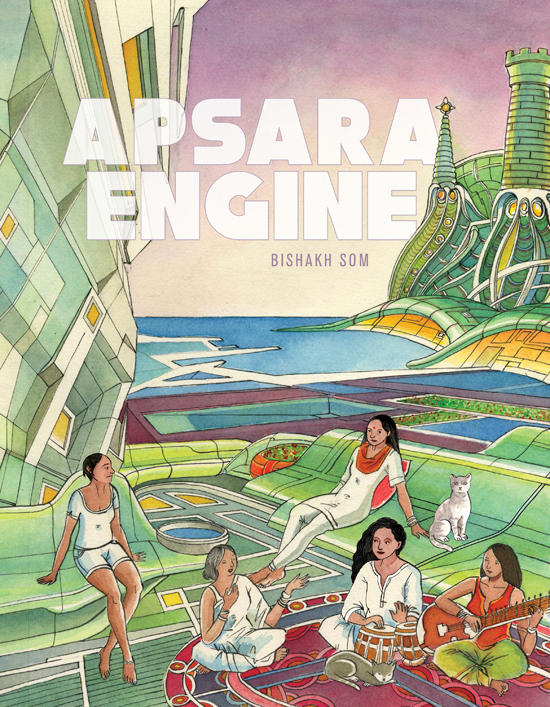
Every story is told for someone to hear, but the teller has no guarantee that they’ll be there to know who heard it. Bishakh Som’s haunting, elliptical stories enter eternity in their weightiest way yet in the nearly 250-page graphic anthology Apsara Engine. Scheherazade and the tale-tellers of The Decameron knew that stories can keep us alive, and are what’s most likely to outlive us; Som’s characters and worlds feel like afterimages of people long gone but vibrantly reverberating, or rough drafts for a promising, indefinite future. Arriving at the same time as a crossroads in human existence, it takes on added relevance but would hold equal significance at any time in history. Fading up and back down again, the collection’s eight tales have in-progress beginnings and ambiguous ends, but each has a vivid past struggling to the surface; if what we know as reality is a veil, in Apsara Engine what’s behind it is blowing the curtain aside whether we seek it or not. The duality of its very title, suggesting Vedic spirituality and relentless tech, speaks of shifting balances and the vital space between; encounters with the supernatural, mythic human/animal hybrids, possibly immortal exiled royalty and mournful backwards time-travelers mix with everyday lost souls in fluid, fanciful metallic sylvan locales that seem like living things themselves. Real-world references and fantastic imaginings collage like the seamless patchwork of dreams, and we don’t know what is paranormal and what may be materialized feelings of guilt or loss or confinement within social norms; but in either case it calls for somehow looking inward but not away. Som and I sat down for a skype about expanding identities, alternate existences, immaterial realities and the intimate cosmos one day in the chilly April of 2020…
HILOBROW: Embodied in the organic yet technological character of the futures — or alternate presents? — that you envision is a kind of optimism, and embrace, of… a trust in a better future, and an embrace of some form of progression from the machinery that we have now. Do you feel that promise is possible, or is it more of an aspirational fantasy?
SOM: I think it’s the latter. The older I grow, and the more the world is clearly starting to devolve, the less faith I have in things like…architecture. Or, architecture as it currently manifests itself, as an enterprise. Which, in retrospect, seems sort of like, it’s almost like an act of violence, right? The act of building has within it this inherent quality of violence toward the Earth. And I don’t know how to get beyond that, in terms of, how to support architecture as an ongoing practice that lives in sympathy with the Earth. The only way I can channel that kind of optimism is through drawing. In a way, it’s like I’m taking the sort of fantasy that is inherent in drawing and — for lack of a better way to put it, paper architecture — to project a future which… on some levels seems optimistic, but is also kind of an illusion. I use the word biomorphic to describe the structures that inhabit my work, and there’s some work being done in the “real world” that is attempting to create buildings that have a less violent impact on the Earth, like, building materials that are made from, let’s say, fungi. But I think we’re a long way off, and I think our inherently aggressive and violent nature as a species is going to do us in before the kind of optimism of technology gets us out of it. If that makes sense.
HILOBROW: It makes perfect sense. In fact, I’m going to go offscreen so I can briefly kill myself.
SOM: OK, I’ll just be over here.
HILOBROW: But, it’s interesting that you brought up biomorphically formed or even biologically sourced architecture, because that’s certainly a premise that your work evokes to me. Because when you said that all architecture, or, all architecture to this point… all architecture in the Anthropocene so far —
SOM: I can’t wait to get out of the Anthropocene.
HILOBROW: Me neither. Though I wouldn’t mind a Gynocene, that would probably be a lot better.
SOM: Yes!
HILOBROW: But, when you were mentioning the violence, I was thinking, there are a few other species who build, be it the dams of beavers or the mounds of termites and ants… and that’s a form of violence, but it’s a conversion of nature, and in that way at least partially a conversation with nature?
SOM: That’s interesting, I hadn’t thought of that.
HILOBROW: And that conversation is inherent in the direction you’re saying human architecture needs to go. We have that quote from, I believe, Winston Churchill, that “We form our buildings, and thereafter they form us,” so how does that relate to your work? Because I definitely get the feeling that all the architecture in your stories is a kind of reverberation of the moods and ways of living of the people in your stories — the way that those cleanly midcentury rectangles make a stage for Sara in “Come Back to Me,” or how the weird, out-of-scale, Romanesque architecture around the people in “throat” gives this vaulting, scary backdrop. Do you see it that way? And as an artist, did those possibilities for materializing thought, projecting character, draw you to architecture, or was it more like your architecture studies made you think, oh, I see how our minds can mold the circumstances of our existence?
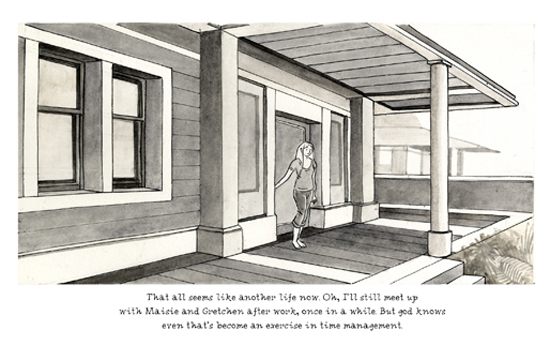
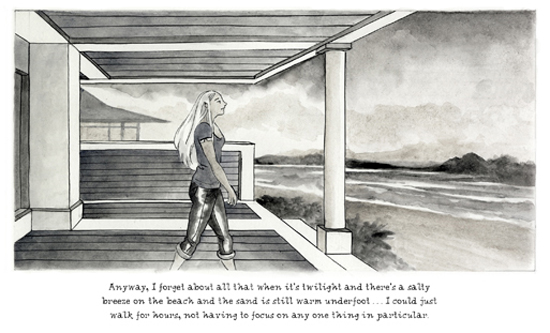
SOM: With those two stories in particular, I was trying to get a very specific architectural context. So, for example in “Come Back to Me,” the specificity of that house they’re living in has to do with their circumstances in terms of their social status and economic status, but also what drew them to the water in the first place, that is talked about early in the story; how they wanted to move closer to the water and be by the beach — that kind of aspirational domesticity turns into something a little more malevolent. So the comfort and domesticity of the backgrounds or the context at the beginning of the story then becomes something a little more fraught.
HILOBROW: When you were talking about the shift from aspiration to more lived complexity with those characters, it occurred to me that, on one level, it could be seen as a revenge of nature…
SOM: Which is kind of what we’re experiencing right now, right?
HILOBROW: Yeah. Though in the case of those characters I wouldn’t be sure if we are seeing a revenge of nature, or just of human nature, since obviously they’re submerging dalliances of theirs that they think don’t matter, but which keep surfacing in the way they relate to each other and how they think of themselves.
You were talking about a decline in faith in the human race getting itself together and figuring out how to live humanely and harmoniously. What is the view in this work toward mortality on a more individual level? Mortality of course is something on everyone’s mind at the current moment. Is the act of telling a story always a kind of elegy, or is the very practice of creativity inherently optimistic?
SOM: That’s a tough one. One the one hand, part of what made it important for me to get this book out was a slightly selfish desire to fix my own legacy, to leave something behind, and make a mark on this world. But I’ve been thinking in the past few weeks how even that kind of hubris, if you can call it that… given the timing of the book coming out this month, even that kind of hubris is being… reacted to by whatever forces govern this cosmos. On the one hand it was sort of raging against the dying of the light and so on and so forth, but at the same time a lot of the stories are like elegies. Especially “Love Song”; the point and tone of that story is sort of a farewell, a love letter, to an existence that is fading. I think elegy is the right word, it’s a memorial to something. And I think the same is true of “Pleasure Palace,” which has in it a sort of love letter to an expired love, and a sort of giving up and resignation to a life beyond… or an existence beyond what you consider to be living. Which comes up in those two stories in particular. That sort of aspiring to live beyond what we think of as a very confined mortal existence. That’s a very high-falutin’ way of putting it, but that has been on my mind.
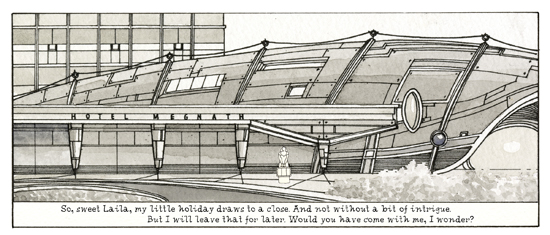
HILOBROW: In “Love Song” there’s the promise of… if not a “better place,” than at least a form of peace, whereas the protagonist of “Pleasure Palace” seems to have gone on existing long after what we would think of as living, just reenacting this cruelty on others that was visited on her lover. Is there a point after which we should stop, that it’s best we not go on existing?
SOM: Whoa. I’m gonna say… well it’s very cynical, because I wanna say yes, and I wanna say yes because, as we were talking about before, our very existence is killing us. The fact that we exist is the thing that is making us unable to exist. In a few of my stories, there’s this idea of retreat, of retreating from the everyday world. That happens a little bit in “Pleasure Palace” but it also has happened in a story that I wrote for the queer paranormal book [The Other Side, 2016], in which the character retreats from everyday life to become a sanyasini, a female hermit. So I think that idea, which is a very core idea of Hinduism, is something that has stayed with me for a long time; this idea that you renounce the world towards the end of your life, and you have as little impact on the Earth as you can get away with, and what that means for the way we consider ourselves to be part of a cycle of life. It’s almost saying, at the end, that you accept that, and that you retreat in order to ease yourself into not existing anymore. I think a lot of the stories are hinting at what that might be like, to ease yourself into slowly disappearing.
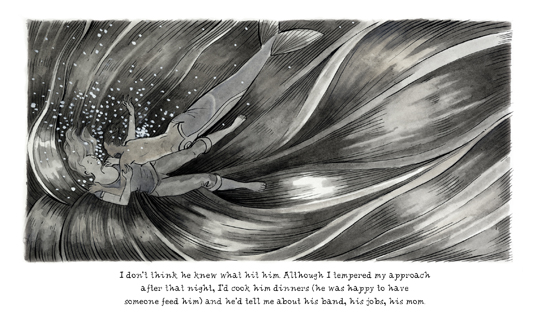
HILOBROW: You made reference to whatever forces are at work in the cosmos. What is your conception of what lies beyond? That’s a trite question, but the unseen is such a presence in your stories, and it seems malleable… how, very often the material seems ephemeral, and sometimes the ephemeral seems material, like when the mer-being is pulling Sara down into the ocean in “Come Back to Me,” the swirl of the water seems like solid mass, and when Maya is dancing in “Pleasure Palace,” the arcs of the air seem like they’re a solid trail. This speaks to material reality being subject to human conception, to a certain extent, or maybe to the whims or the aims of some higher collective intelligence. When we’re gone, is there a place that we’re gone to, or…
SOM: That’s a big one.
HILOBROW: I mean, within the cosmology of your own work. Which might in fact be different than in your everyday life…
SOM: With respect to the ethereal becoming more tangible, to a certain degree that may have to do — and I could be totally blowing smoke here, but — it might have to do with this idea of “Maya,” which is the name of the character you mentioned, but it’s also the idea [in Hindu philosophy] that all of this [gestures around the room] is an illusion. That we’re unable to perceive a true reality because of our low-level status as human beings. So, trying to draw out — literally draw — some of these unseen aspects of what may be surrounding us, maybe that’s what I was trying to do; but if I did it, I think I did it subconsciously or without intending to have some kind of motive behind it. It just sort of seemed like… yeah, of course there are these things that surround us that can be made manifest through drawing and through comics. Sometimes it’s as simple as referring to motion lines or things like that, but I think I was taking it towards a more fluid, ethereal level.
As far as what I think happens in the grand scheme of things? Again, going back to Hindu thought, that’s the way I was brought up, is to believe in the idea that we’re endlessly reincarnated until we figure out how to get out of it, which is then to achieve some kind of super-consciousness that will liberate us. And… I don’t know, I aspire to that kind of liberation, but I don’t have anything to back that up with, it’s just pure faith.
HILOBROW: Which is the definition of faith, so. And it intersects with what seems to be the growing convergence in public thought between faith and science — that malleability you were talking about, the fluidity of portraying material forces, is like the visualization of dark matter and that kind of thing. That everything is actually interlocking, or y’know, there’s that cliché about how a fish doesn’t know it’s in water; when I see scenes like that one of Maya dancing, I know that I’m in air.
SOM: I think that’s where art can do something that neither faith nor science can do — bring those kinds of visualizations into being, and render different realities. Science-fiction does that too, which is why I’m so interested in it. They are both tools of visualizing and conceptualizing things that are beyond our ken.

HILOBROW: Was there ever a time when you were either committing to, or [your stories] happened to be coming out as, “pure” science-fiction, a purely future world? Because these days it’s more like a parallel present in all of your stories, and we accept that this is an alternate everyday. Which kind of aligns with William Gibson’s shift from doing things that were set in “the future” to things which are set in a present.
SOM: I’ve always wanted to do, for lack of a better word, a “straight” SF story… [laughs]
HILOBROW: Someday that will be an archaeological title for college classes!
SOM: Right [laughs]. I’ve had ideas for stories like that, and had a very specific idea of how those stories would be drawn; I just never got around to it, honestly. I was thinking a lot about how the aesthetic and ideas I wanted to channel came from one book in particular from when I was growing up, which was a choose-your-own-adventure book, called “Return… to Planet XL?” — something like that. Anyway, the drawings were just amazing, and the world the drawings conveyed was something I was so drawn to. And I still want to do a kind of riff on that; not in terms of making a choose-your-own-adventure book, but in channeling the kind of ’60s/’70s retro SF look into a story, but with themes that are more relevant and contemporary to me. But these drawings were great, they look a lot like… very of a certain time, when there was that fluidity to the line and the characters all looked like Stereolab album covers? And I really did want to commit to genre as an exercise at one point, but I haven’t done that yet.
HILOBROW: It almost seems like science fiction is being superseded… Gibson’s other much-repeated truism that I never get tired of is that “the future is already here, it’s just not distributed evenly”; your work materializes that, in the way that the arcadian past is at the left of the panel and the sleek future is at the right of the panel [laughter]… and I think more and more we’re feeling that slippage, that tidal ebb and flow — even more so during a pandemic, where we all now look to South Korea as a more advanced society than ours, in terms of its capability to actually keep people alive. So your blend seems very relevant to me.
SOM: Thank you… I hadn’t thought about this, but doing something like what I was mentioning, going back to genre, is almost like doing the opposite of what science fiction is supposed to do — I find a kind of nostalgia and comfort in the aesthetics of that. So it’s almost like going backwards, in order to, again, retreat from what’s happening now. But the work of science fiction and of forward-thinking comics would be to get us out of that comfort, or that cocoon of longing for something that is from a “simpler time” or whatever. But I would still love to just do it as an exercise, and see what happens. Maybe it will go off on its own tangent, become something completely different. Which probably it will do.
HILOBROW: That’s a really great conceptual framework for it, and something that never really occurred to me, that, yes, traditional science-fiction is now nostalgia — which is very valid in itself, as a barometer of where we actually are now. And actually would tie in with that elegiac quality we were talking about before… one term that David Bowie was fond of using for songs like “Ashes to Ashes” was “nostalgia for a future”… and of course he was ahead of his time with that since we weren’t yet all talking to each other on computer screens.
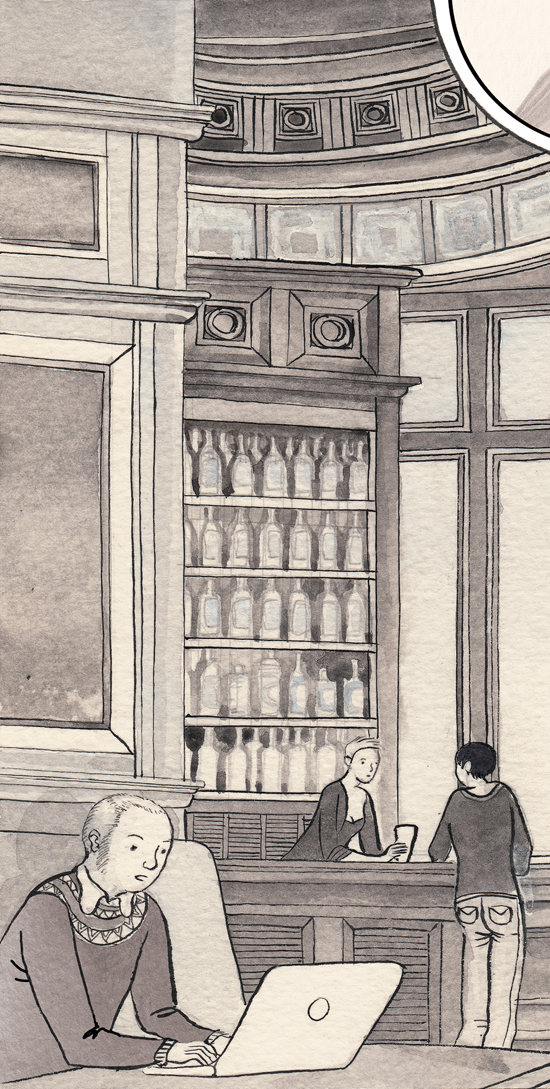
SOM: That’s probably why “speculative fiction” is having its heyday now…and I’m not even sure how to define that term, and I know that term has been used to define this book; I don’t even know how I feel about that. I don’t know if it applies or not.
HILOBROW: I remember that being a term that was championed by Harlan Ellison in the 1970s, as an alternative to “sci-fi” which he thought was a loathsome trivializing term. But “speculative” does assume a linear timeline… an imaging of what is to come, whereas the feeling I get from your stories, and from most fiction these days, is more of an adjacency: what are the possibilities of how things might have gone that are existing right next to us in time?
SOM: That’s what I was getting at in “Swandive,” exactly, is the way the two characters draw themselves into either futures or presents where they meet each other again and again in different circumstances or different contexts; that idea of adjacent possibilities was exactly what I was trying to get at.
HILOBROW: One thing that does seem projected in the book is that… these stories do seem to take place in a world — or, maybe just a social circle, or is it an entire world? — where everyone is materially sustained and sufficiently comfortable… and maybe even in a state where they have the time and means to contemplate how empty their lives may be in other ways? Is that a fantasia, or is it an aspect of futurity in some way, like: we’ve removed the survival conflicts so we can make room for the existential questions?
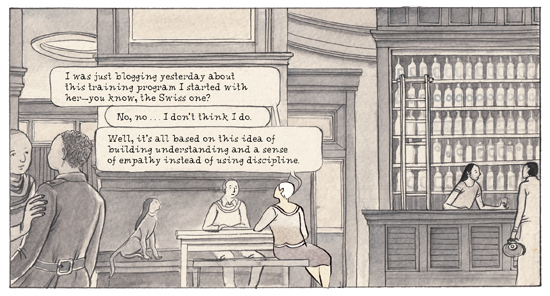
SOM: I think that’s true only in one story, which is “Swandive,” where they imagine a sort of queer and trans South Asian utopia [smiles], where all of these great things are possible, like, schools for kids who just want to learn anything they want to… a future of plenty and… a queer socialist utopia. But I think that’s the only story where that kind of imaging of the future as a land of plenty occurs.
In the other stories I get what you’re saying about the characters being of a certain social niche; I think I’m very aware of that because that’s my own background, and it’s a reflection of my privilege, and the way I grew up. And after I finished the book I was becoming very aware of the possible criticism that might be leveled at the book as being very of a certain class, namely upper middle class, and all the characters inhabiting that very specific world, even though the edges of that world are pretty blurry. But I think I was writing what I knew. Doing the work of writing what I don’t know would require a degree of research that I didn’t have in me when I was writing this book. And this book dates back quite a ways, I would say even to 2003, when I was just wanting to get something out there, so I was just drawing on my own experiences, drawing out of my own resources as a sort of psychic library. But to try and write from outside of myself is another project, which I wasn’t ready to undertake.
There are some instances — and this goes back to what we were talking about in terms of retreating — there are some instances of characters trying to give up the material comforts of their existence, and then retreating into either a more celestial existence or a more spartan existence. But…those are strategies that depend on them being in a sort of comfortable milieu to begin with, so yeah, I am aware that these characters inhabit that kind of context, and I’m not sure what to do about it, other than to say, I was writing and drawing on my experience, for this particular book. Maybe in the future I can so something a little more outside myself.
HILOBROW: Sure. It’s just intriguing and enlightening to be able to situate these characters and these narratives in the constellation of circumstance… as I was reading this it wasn’t like, “Where does this girl get off?!” [laughter], it was more like, where does this book fit. Certainly, there are parallel states of being even on single social echelons; there’s been waves of immigrants to America, Jews [points a thumb at himself] to begin with, South Asians more recently, who climb the ladder and become established, but whom no one would consider to be elite.
One thing that really interests me is the use of silence in these comics, the way that you’ll have all these pans around the crowd during a conversation. Since you are both a verbal artist and a visual artist — and, I would say, a spatial artist because of your architectural background — do you find that your process involves a kind of mental reconnaissance of the imaginary setting before words come into it?
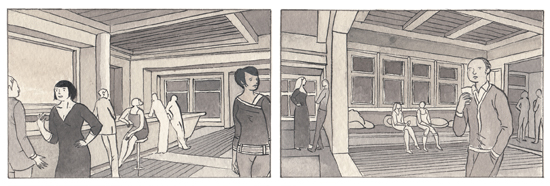
SOM: I’m thinking of two stories in particular; “Swandive” and “Meena and Aparna.” With “Meena and Aparna” at least, that was maybe one of the first stories that I started by writing a script, as opposed to doing a “visual script,” let’s say, and I actually wrote it out as language first. I think doing that made me more aware of how to choreograph the silences and the beats. Once I moved from the script to the thumbnails that became even more relevant and important. Honestly it wasn’t too deliberate on my part; it just seemed kind of natural, in certain instances, for one character not to say something right after the other character had said something, for there to be a beat where one character is processing what the other is saying. So it only makes sense to then have either a silent panel, or to pull back from that, to say, there is an atmospheric moment happening here that is more about the inner world of the characters than what’s being said between them.
Sometimes it had to do with a filmic way of looking at comics — which I know is a little retrograde, maybe? — thinking in terms of camera angles and shots and setting. I’m aware of those techniques of pulling back, and using that as a moment of pause. Sometimes I want to get away from that idea, that the comic is a film, but sometimes I’m drawn back into it. I never studied scriptwriting, but I think maybe those things are tools that are as inherent in scriptwriting as words are. [So] I was very aware of doing that, but it also seemed like, how could I not do it; otherwise it would just be like one bit of dialogue after another. Maybe that’s just the nature of the story, because some of the stories start out as pure conversation, but the conversation itself has inherent to it filler, and emptiness, and gaps and pauses. So I wanted to build that in. In the same way that I call out certain architectural details, to lend a degree of realism, I also wanted to have the rhythms and pace of everyday conversation be part of the storytelling mode of the comic. And that involves sometimes dropping out color, sometimes pulling back or having the characters not say anything, or focusing on something else… what Scott McCLoud calls the aspect-to-aspect transition between panels. I guess I was aware of that in the back of my head, but it seemed sort of natural to me to do that, because of the tone of the stories themselves.
HILOBROW: It’s about not leaving out context… context I guess is the negative space of experience, so it can’t not be there. I’ve never agreed, actually, that the comparison between comics and film is retrograde, because… I know that a lot of people who do think that, do so on the basis that it’s going outside of the medium for references, but the nature of comics is hybrid to begin with, it’s visual and verbal, so I think it’s fair game to have a number of different mediums’ techniques intersect in it as well.
In any case, I think that with things like those pans around the room, it’s more like the comic and the film have a common source. At no point, reading those scenes in Apsara Engine, did I think of them as “cinematic,” it just evoked what it feels like to have an actual conversation, have your mind wander around the room… and you mentioned the dropping out of color; I think that’s one of the many cases where you are using comics’ own vocabulary.
What about wider context — reading a piece like the title story, “Apsara Engine” now, the checklist being made by one character could easily be from the COVID-19 era, and the unrest that a few others are in the middle of will remind everyone of recent uprisings in Hong Kong, even though that story first appeared in another form years ago. What part does specific reference, either historical or personal, play in these stories?
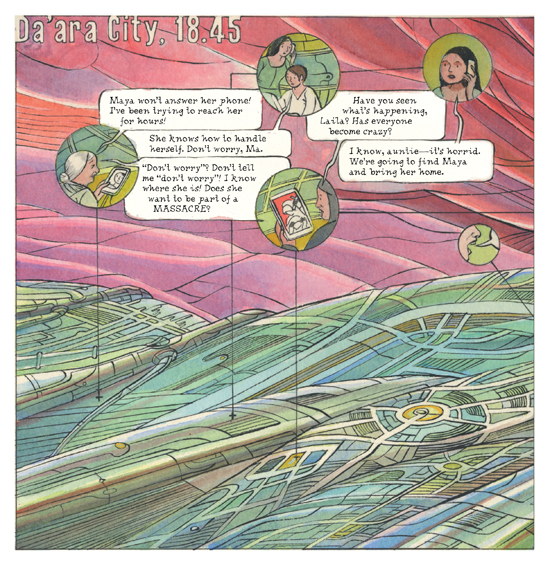
SOM: Definitely with “Apsara Engine”… I wrote that story around the time of the Arab Spring and the Green Revolution in Iran, so I was drawing a little bit on what was happening in the world, but then sort of telescoping it, or making it part of… I think the prompt for that story — which I originally did for an academic journal [Specs, Rollins College] — was kaleidoscopic points or moments. So the way I interpreted it is this idea that there’s a multiplicity of experiences going on at the same time, so I was trying to get at how to depict that within the medium of comics. I also brought in this idea of architectural representation, to try and convey multiple moments at the same time. So to that degree its context and reference was important, because I was drawing on real-world events, to say that, these things happen as part of a kaleidoscope of experiences within parallel lives.
But as I was drawing the book I was getting away a little bit from that, from referring to things in the real world too explicitly. Even though some of the stories take place in Brooklyn — there’s a reference to Smith St. in “Meena and Aparna,” which I guess is the most grounded story in the whole collection [smiles] — but even then, as I was writing and drawing it I was like, well, this is not really about “living in Brooklyn,” it’s about something completely different, so those details either became less important, or, they became part of the general tapestry of what counts as context.
HILOBROW: Did you say that “Meena and Aparna” was the only story that you did a written-down script for?
SOM: No, “Swandive” I did a written script for, and I probably did for “I Can See It in You” because it’s so word-heavy [laughs], and then the other ones like “Love Song” and “Come Back to Me,” because they’re dependent on either a connection or a disconnection between the word and the image, for the most part a disconnection, I had to do a more simultaneous “scripting,” working between language and image. The longer stories were definitely scripted. Even though, “Pleasure Palace,” which I think is the oldest story in the book, if I was scripting I was doing it very informally — I’ve refined or processed that story a couple of times… but it didn’t start off purely as a script.
HILOBROW: It’s interesting to think of “Swandive” as having a verbal script to begin with, because it ends as a completely sensory experience.
SOM: Right, so, with the script for that… yeah, the last part of it is like, “Well, you’ll just have to see” — there’s no way to put it in words. So I found that slightly exhilarating!
HILOBROW: And that was a very visible structural evolution, ’cuz it literally begins with a lecture, and ends up in pure experience. Was that the story you were asked to incorporate, and were you comfortable with it?
SOM: Yes. I didn’t know where it was going to go in the beginning, and I think the prompt for that story is that, I wanted to write something that was more explicitly trans-centered. Because a lot of the relationships in the rest of the book are queer… or queered [smiles]… but it’s a sort of implicit queerness, or an unearthed queerness. “Swandive” is the newest story, and the most relevant to my experience as a trans person now; all of the other stories were written before I “hatched” as a trans person. I really wanted to have a story in the book that was more legible as an explicit trans story, but I was also thinking, how do I write a trans story that isn’t just relying on familiar tropes. And what that might mean to the way I drew the story and the way the story unfolds, both in terms of its structure but also visually. I’m not saying that what happens at the end of that story is a trans motif or strategy, but it could be. I would like to think that the way it evolves, or… sublimates from the literal to pure experience can be considered a way of thinking of trans storytelling — in the same way that the lead character is, like, “Well, what does it mean to be doing trans cartography or geography” — so the drawing of the comic then is a parallel exercise to the drawing of the maps in the story, and I think of those two as possible new trans strategies.
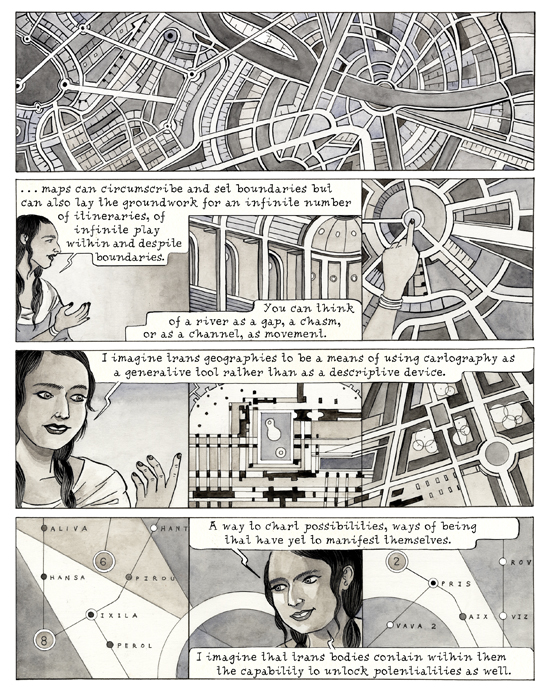
HILOBROW: There is an interesting counterpoint, in “Swandive,” between people discoursing about how to be accepted as themselves, and then the first time they get alone Amrit is immediately freaked out by Onima, who’s getting ready to literally paint in her own blood. So there is this theme of barriers that need to be breached, how the sphere of one’s acceptance has to always keep expanding? How, you can be a person who has to struggle for acceptance, but you can have barriers and limits too, and it’s actually a good thing that we have to always be pushing against that?
SOM: Particularly in “Swandive” I was thinking of the progression from flirting to one-hundred-percent immersion in love, and how that may or may not become a sort of revelation, and sort of overwhelm you. There’s the not-knowing of flirtation, there’s a charm and magic to that that’s like pixie-dust, that then coalesces into a really deeper form of magic. When you come to certain realizations about what it means to love. There’s a quality of epiphany to that. I don’t know where that comes from, but one thing I guess I’m always aware of, again going back to Hindu texts and things that I grew up with, is this idea in the Bhagavad Gita of Krishna revealing himself to Arjuna on the battlefield, and that kind of revelation and epiphany that’s so overwhelming that you can’t even process it. And all the things that led up to that, the friendship between those two characters, there was a certain magic to that, but I found that some sort of — not sudden, but decisive transition between the more earthbound relationship and the full-on, cosmic wonder of who Krishna really is, that revelation, to be something I was channeling, in a smaller way, in some of the stories.
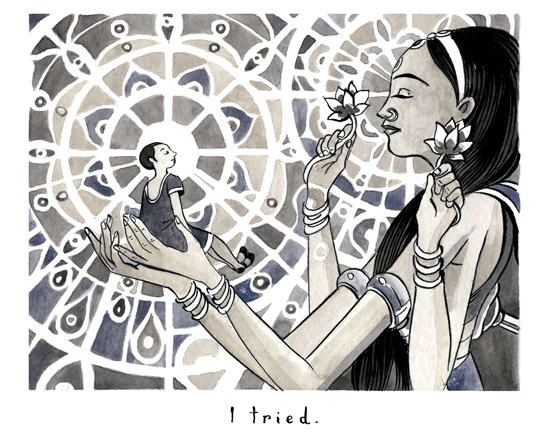
[Other lives of Bishakh Som at HILOBROW: here and elsewhere]
MORE POSTS by ADAM McGOVERN: OFF-TOPIC (2019–2025 monthly) | textshow (2018 quarterly) | PANEL ZERO (comics-related Q&As, 2018 monthly) | THIS: (2016–2017 weekly) | PEOPLE YOU MEET IN HELL, a 5-part series about characters in McGovern’s and Paolo Leandri’s comic Nightworld | Two IDORU JONES comics by McGovern and Paolo Leandri | BOWIEOLOGY: Celebrating 50 years of Bowie | ODD ABSURDUM: How Felix invented the 21st century self | CROM YOUR ENTHUSIASM: C.L. Moore’s JIREL OF JOIRY stories | KERN YOUR ENTHUSIASM: Data 70 | HERC YOUR ENTHUSIASM: “Freedom” | KIRK YOUR ENTHUSIASM: Captain Camelot | KIRB YOUR ENTHUSIASM: Full Fathom Five | A 5-part series on Jack Kirby’s Fourth World mythos | Reviews of Annie Nocenti’s comics Katana, Catwoman, Klarion, and Green Arrow | The curated series FANCHILD | To see all of Adam’s posts, including HiLo Hero items on Lilli Carré, Judy Garland, Wally Wood, and others: CLICK HERE
